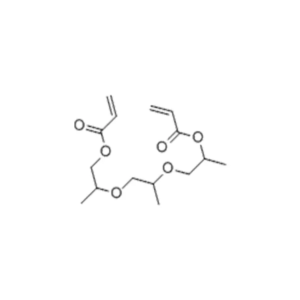描述
TMPTMA 单体/三羟甲基丙烷三甲基丙烯酸酯 CAS 3290-92-4
外观 |
无色透明液体 |
化验 |
99.5%min |
异构体 |
0.1%max |
游离酸 |
0.2%max |
该产品可替代三羟甲基丙烷三甲基丙烯酸酯;ACRYESTER TMP;MIRAMER M301;Trimethacrylate de propylidynetrimethyle;Trimetacrilato de propilidintrimetilo;2,2-双[(甲基丙烯酰氧基)甲基]丁基甲基丙烯酸酯(非首选名称);EBECRYL TMPTMA。
三羟甲基丙烷三甲基丙烯酸酯的用途
1.三羟甲基丙烷三甲基丙烯酸酯可用作过氧化物交联的交联剂。适用于混合聚丁二烯二丙烯酸酯、聚(丙烯-共乙烯)、三元乙丙橡胶、异戊二烯橡胶、丙烯腈-丁二烯橡胶。
2.三羟甲基丙烷三甲基丙烯酸酯可用作硫化剂。当合成橡胶与过氧化物硫化时,TMPTMA 可提高耐腐蚀性、耐老化性和硬度、耐热性。TMPTMA 在混炼过程中会塑化,硫化后具有原有的硬化效果,可用于 NBR、EPDM、丙烯酸橡胶。
3.三羟甲基丙烷三甲基丙烯酸酯可用作交联剂。TMPTMA 可减少辐射剂量,缩短辐射时间,提高交联密度,并具有精度低、交联度高、蒸汽压低、固化速度快等特点。它可用于光固化油墨和光。聚合材料。
4.将 PVC 混入车身密封剂、填缝剂和所有 PVC 溶液中成型。
5.特种橡胶的硫化辅助活化剂、乙丙橡胶和三元乙丙橡胶(EPDM)、氯橡胶、硅橡胶、聚氨酯、乙烯/醋酸乙烯共聚物(EVA)、氯化聚乙烯弹性体(CPE)及其他特种橡胶 硫化非常困难,一般采用有机过氧化物(如 DCP、BPO)进行硫化。如果使用单一的有机过氧化物进行硫化,硫化时间过长,硫化不充分,很难保证良好的机械和物理性能。因此,必须添加 TMPTMA 作为硫化剂,才能达到良好的效果。
6.例如,有机氟橡胶等,在使用 DCP 进行硫化时,如果使用添加剂 1~4% TMPTMA 作为硫化剂,不仅可以大大缩短硫化时间,提高硫化程度,减少 DCP 的用量,还能显著提高产品的机械。强度、耐磨性、耐溶剂性和耐腐蚀性等。在含氟橡胶的硫化过程中,TMPTMA 分子中的双键不仅参与硫化交联反应,还充当卤化氢(HF、HCL 等)受体,吸收加工过程中释放的卤化氢,从而不仅提高了产品质量,还大大降低了硫化橡胶的腐蚀性。含有 TMPTMA 的橡胶复合物在混炼时具有塑化效果,在硫化后具有硬化效果。
三羟甲基丙烷三甲基丙烯酸酯的包装和运输
包装:1/公斤;200公斤/桶
送货:海运、空运和 DHL
三羟甲基丙烷三甲基丙烯酸酯的储存
低温避光保存。
立即联系我们!
如果您需要价格和样品测试,请在下表中填写您的联系信息,我们通常会在 24 小时内与您联系。您也可以给我发电子邮件 info@longchangchemical.com 请在工作时间(UTC+8 周一至周六,上午 8:30 至下午 6:00)或使用网站即时聊天工具获得及时回复。
| 聚硫醇/聚硫醇 | ||
| CHLUMICRYL®DMES 单体 | 双(2-巯基乙基)硫醚 | 3570-55-6 |
| CHLUMICRYL® DMPT 单体 | THIOCURE DMPT | 131538-00-6 |
| CHLUMICRYL® PETMP 单体 | 7575-23-7 | |
| CHLUMICRYL® PM839 单体 | 聚氧(甲基-1,2-乙二基) | 72244-98-5 |
| 单官能团单体 | ||
| CHLUMICRYL® HEMA 单体 | 甲基丙烯酸 2-羟乙基酯 | 868-77-9 |
| CHLUMICRYL® HPMA 单体 | 甲基丙烯酸羟丙酯 | 27813-02-1 |
| CHLUMICRYL® THFA 单体 | 丙烯酸四氢糠酯 | 2399-48-6 |
| CHLUMICRYL® HDCPA 单体 | 氢化双环戊烯丙烯酸酯 | 79637-74-4 |
| CHLUMICRYL® DCPMA 单体 | 甲基丙烯酸二氢双环戊二烯酯 | 30798-39-1 |
| CHLUMICRYL® DCPA 单体 | 丙烯酸二氢双环戊二烯酯 | 12542-30-2 |
| CHLUMICRYL® DCPEMA 单体 | 甲基丙烯酸二环戊氧基乙酯 | 68586-19-6 |
| CHLUMICRYL® DCPEOA 单体 | 丙烯酸二环戊烯基氧基乙基酯 | 65983-31-5 |
| CHLUMICRYL® NP-4EA 单体 | (4) 乙氧基化壬基酚 | 50974-47-5 |
| LA 单体 | 丙烯酸十二烷基酯/丙烯酸十二烷基酯 | 2156-97-0 |
| CHLUMICRYL® THFMA 单体 | 甲基丙烯酸四氢糠酯 | 2455-24-5 |
| CHLUMICRYL® PHEA 单体 | 2-苯氧基乙基丙烯酸酯 | 48145-04-6 |
| CHLUMICRYL® LMA 单体 | 甲基丙烯酸月桂酯 | 142-90-5 |
| CHLUMICRYL® IDA 单体 | 丙烯酸异癸酯 | 1330-61-6 |
| CHLUMICRYL® IBOMA 单体 | 甲基丙烯酸异冰片酯 | 7534-94-3 |
| CHLUMICRYL® IBOA 单体 | 丙烯酸异冰片酯 | 5888-33-5 |
| CHLUMICRYL® EOEOEA 单体 | 2-(2-乙氧基乙氧基)丙烯酸乙酯 | 7328-17-8 |
| 多功能单体 | ||
| CHLUMICRYL® DPHA 单体 | 29570-58-9 | |
| CHLUMICRYL® DI-TMPTA 单体 | 二(三羟甲基丙烷)四丙烯酸酯 | 94108-97-1 |
| 丙烯酰胺单体 | ||
| CHLUMICRYL® ACMO 单体 | 4-丙烯酰基吗啉 | 5117-12-4 |
| 双功能单体 | ||
| CHLUMICRYL® PEGDMA 单体 | 聚乙二醇二甲基丙烯酸酯 | 25852-47-5 |
| CHLUMICRYL® TPGDA 单体 | 三丙二醇二丙烯酸酯 | 42978-66-5 |
| CHLUMICRYL® TEGDMA 单体 | 三乙二醇二甲基丙烯酸酯 | 109-16-0 |
| CHLUMICRYL® PO2-NPGDA 单体 | 丙氧基新戊二醇二丙烯酸酯 | 84170-74-1 |
| CHLUMICRYL® PEGDA 单体 | 聚乙二醇二丙烯酸酯 | 26570-48-9 |
| CHLUMICRYL® PDDA 单体 | 邻苯二甲酸二乙二醇二丙烯酸酯 | |
| CHLUMICRYL® NPGDA 单体 | 新戊二醇二丙烯酸酯 | 2223-82-7 |
| CHLUMICRYL® HDDA 单体 | 二丙烯酸六亚甲基酯 | 13048-33-4 |
| CHLUMICRYL® EO4-BPADA 单体 | 乙氧基化 (4) 双酚 A 二丙烯酸酯 | 64401-02-1 |
| CHLUMICRYL® EO10-BPADA 单体 | 乙氧基化 (10) 双酚 A 二丙烯酸酯 | 64401-02-1 |
| CHLUMICRYL® EGDMA 单体 | 乙二醇二甲基丙烯酸酯 | 97-90-5 |
| CHLUMICRYL® DPGDA 单体 | 二丙二醇二烯酸酯 | 57472-68-1 |
| CHLUMICRYL® 双-GMA 单体 | 双酚 A 甲基丙烯酸缩水甘油酯 | 1565-94-2 |
| 三官能单体 | ||
| CHLUMICRYL® TMPTMA 单体 | 三羟甲基丙烷三甲基丙烯酸酯 | 3290-92-4 |
| CHLUMICRYL® TMPTA 单体 | 三羟甲基丙烷三丙烯酸酯 | 15625-89-5 |
| CHLUMICRYL® PETA 单体 | 3524-68-3 | |
| CHLUMICRYL® GPTA ( G3POTA ) 单体 | 丙氧基三丙烯酸甘油酯 | 52408-84-1 |
| CHLUMICRYL® EO3-TMPTA 单体 | 三羟甲基丙烷三丙烯酸乙氧基化物 | 28961-43-5 |
| 光阻单体 | ||
| CHLUMICRYL® IPAMA 单体 | 2-异丙基-2-金刚烷基甲基丙烯酸酯 | 297156-50-4 |
| CHLUMICRYL® ECPMA 单体 | 1-乙基环戊基甲基丙烯酸酯 | 266308-58-1 |
| CHLUMICRYL® ADAMA 单体 | 1-金刚烷基甲基丙烯酸酯 | 16887-36-8 |
| 甲基丙烯酸酯单体 | ||
| CHLUMICRYL® TBAEMA 单体 | 2-(叔丁基氨基)乙基甲基丙烯酸酯 | 3775-90-4 |
| CHLUMICRYL® NBMA 单体 | 甲基丙烯酸正丁酯 | 97-88-1 |
| CHLUMICRYL® MEMA 单体 | 甲基丙烯酸 2-甲氧基乙酯 | 6976-93-8 |
| CHLUMICRYL® i-BMA 单体 | 甲基丙烯酸异丁酯 | 97-86-9 |
| CHLUMICRYL® EHMA 单体 | 甲基丙烯酸 2-乙基己酯 | 688-84-6 |
| CHLUMICRYL® EGDMP 单体 | 乙二醇双(3-巯基丙酸酯) | 22504-50-3 |
| CHLUMICRYL® EEMA 单体 | 2-甲基丙-2-烯酸 2-乙氧基乙酯 | 2370-63-0 |
| CHLUMICRYL® DMAEMA 单体 | 甲基丙烯酸 N,M-二甲基氨基乙酯 | 2867-47-2 |
| CHLUMICRYL® DEAM 单体 | 甲基丙烯酸二乙氨基乙酯 | 105-16-8 |
| CHLUMICRYL® CHMA 单体 | 甲基丙烯酸环己基酯 | 101-43-9 |
| CHLUMICRYL® BZMA 单体 | 甲基丙烯酸苄酯 | 2495-37-6 |
| CHLUMICRYL® BDDMP 单体 | 1,4-丁二醇二(3-巯基丙酸酯) | 92140-97-1 |
| CHLUMICRYL® BDDMA 单体 | 1,4-丁二醇二甲基丙烯酸酯 | 2082-81-7 |
| CHLUMICRYL® AMA 单体 | 甲基丙烯酸烯丙酯 | 96-05-9 |
| CHLUMICRYL® AAEM 单体 | 甲基丙烯酸乙酰乙酰氧基乙基酯 | 21282-97-3 |
| 丙烯酸酯单体 | ||
| CHLUMICRYL® IBA 单体 | 丙烯酸异丁酯 | 106-63-8 |
| CHLUMICRYL® EMA 单体 | 甲基丙烯酸乙酯 | 97-63-2 |
| CHLUMICRYL® DMAEA 单体 | 丙烯酸二甲胺基乙酯 | 2439-35-2 |
| CHLUMICRYL® DEAEA 单体 | 2-(二乙基氨基)乙基丙-2-烯酸酯 | 2426-54-2 |
| CHLUMICRYL® CHA 单体 | 丙-2-烯酸环己基酯 | 3066-71-5 |
| CHLUMICRYL® BZA 单体 | 丙-2-烯酸苄酯 | 2495-35-4 |
| 其他单体 | ||
| CHLUMICRYL® MCPMA 单体 | 1-甲基环戊基甲基丙烯酸酯 | 178889-45-7 |
| CHLUMICRYL® TMPMP 单体 | 三羟甲基丙烷三(3-巯基丙酸酯) | 33007-83-9 |
| CHLUMICRYL® CTFA 单体 | 环状三甲基丙烷正式丙烯酸酯 | 66492-51-1 |
| CHLUMICRYL® HPHPDA 单体 | 30145-51-8 | |
| CHLUMICRYL® MPEG 单体 | 26915-72-0 | |







利亚姆-卡特 -
交货迅速,质量上乘。没有比这更好的了!我对这次购物非常满意。